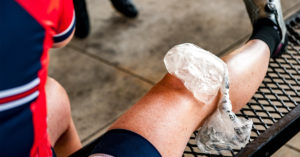May 2, 2022Warming Up to Therapy Options Other than Ice
In a 2011 study, people who iced a torn calf muscle felt just as much leg pain later as those who left their sore leg alone, and they were unable to return to work or other activities any sooner. Similarly, a 2012 scientific review concluded that athletes who iced sore muscles after strenuous exercise — or, for the masochistically minded, immersed themselves in ice baths — regained muscular strength and power more slowly than their unchilled teammates.
And a sobering 2015 study of weight training found that men who regularly applied ice packs after workouts developed less muscular strength, size, and endurance than those who recovered without ice.
 Even Harvard physician Dr. Gabe Mirkin, who coined “the R.I.C.E. (rest, ice, compression, and elevation) protocol” in 1978, has shied away from his own theory. These days, he tells anyone who will listen that he was wrong about both rest and ice. He wrote the forward to Gary Reinl’s 2013 self-published book, Iced! The Illusionary Treatment Option has become the bible of the growing anti-ice movement.
Even Harvard physician Dr. Gabe Mirkin, who coined “the R.I.C.E. (rest, ice, compression, and elevation) protocol” in 1978, has shied away from his own theory. These days, he tells anyone who will listen that he was wrong about both rest and ice. He wrote the forward to Gary Reinl’s 2013 self-published book, Iced! The Illusionary Treatment Option has become the bible of the growing anti-ice movement.
“My RICE guidelines have been used for decades, but new research shows rest and ice actually delay healing and recovery,” says Mirkin, now 84.
Yes, says Mirkin, if your muscles are sore, you can relieve that pain with ice. But the inflammation causing that soreness is actually bringing healing to the body; by icing, you “dampen that immune response,” he says. “You think you’re recovering faster, but science has shown you’re not.”
When tissue is damaged, the immune system initiates that inflammatory response, which a 2010 study published in the Federation of American Societies for Experimental Biology Journal showed is necessary to heal damaged tissue and repair muscle. The body deploys its repair and cleanup crew in the form of macrophages, white blood cells that engulf and digest cellular debris. They produce the protein insulin-like growth factor 1, which is required for muscle repair and regeneration. The same study showed that blocking inflammation delays healing by preventing the release of IGF-1.
Ice delays this process by constricting blood vessels and allowing less fluid to reach the injured area, as demonstrated in a 2013 study in the Journal of Strength and Conditioning Research. This research showed that topical cooling delays recovery from eccentric exercise-induced muscle damage. Additionally, a 2015 article published in Knee Surgery, Sports Traumatology, Arthroscopy showed that the narrowing of blood vessels caused by icing persists after cooling ends and the resulting restriction of blood flow can kill otherwise healthy tissue; that is, icing causes more damage to the existing injury.
This isn’t just about serious injuries, either; it’s about the way you recover from workouts. Remember: having very sore quads because of a workout is different from a torn quadriceps only by degrees. A 2014 study published in the Journal of Strength & Conditioning Research and another done by the University of Queensland showed cold water immersion after training — ice baths — substantially reduce long-term gains in muscle mass and strength by stunting the cell activity crucial for building stronger muscles. When you hit the cold tub after hard exercise, thinking you are reducing inflammation, you’re delaying recovery.
Inflammation and swelling have been deemed the enemy, but only swelling is actually bad. “Inflammation is a process the body uses to heal tissue, while swelling is a byproduct of that process,” says Dr. Joshua Appel, an Air Force flight surgeon for the 306th Pararescue Squadron and chief of emergency medicine at Southern Arizona VA Healthcare System. “When you recruit inflammatory markers to an acutely injured area, with that comes fluid. The body knows how to heal itself, so you’re not getting too much fluid. But you can have not enough evacuation.”
» ALSO SEE: Tips for Integrating the Snatch and Clean & Jerk
This swelling reduces naturally via the lymphatic system, a map of one-way vessels that remove waste products from the body. However, the lymphatic system is passive, meaning it doesn’t work automatically. It only removes waste when muscles contract, so if you sit still and ice your muscles, waste doesn’t get removed. Applying ice to an inflamed area actually slows down the healing process. The metabolic process described above slows to a halt and puts the brakes on the outflow of swelling and influx of healing nutrients. Essentially, ice hits the pause button on the healing process, which delays muscle recovery as demonstrated by a 2013 study in the Journal of Strength and Conditioning Research.
Ice is the cheapest, most readily available non-habit-forming way to alleviate pain. But be warned: the pain will return once the tissue rewarms and the inflammatory response resumes.
That’s because the inflammatory response needs to happen.
The three stages of healing for soft tissue injuries are now universally accepted by the medical community: inflammation, repair, and remodeling. And you can’t reach the repair and remodeling phases until you’ve gone through Phase One.



